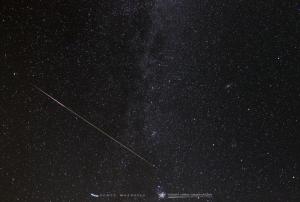Meteor Showers and Sporadic Meteors
We were very pleased The Rhode Island Monthly Magazine voted Frosty Drew Observatory as the Best Of Rhode Island in the "for free" category. We competed against all other free organizations for this award.
Meteors come in two general categories. The first category, showers, are associated with active comet tails for the most part. When the Earth passes directly though a large comet's tail, the rates of meteors can climb from a few per hour up into the hundreds and sometimes thousands of meteors per hours. The Leonid's in the third week of November have been spectacular for several years. If you trace the paths of meteors in a shower backwards the paths seem to cross a point in the sky called the radiant. This is where the comet trail is intersecting the Earth.
The second category, sporadic, seem to come at all times of the year and they don't seem to trace back to any single point in the sky. We think that such meteors are associated with long ago comets that are no longer producing trails, either because the comet has largely evaporated or the comet has left the central Solar System all together. After a few hundred years, these cometary dust tails dissipate leaving only sporadic meteors.
September is a wonderful month for minor showers and sporadic meteors. Don't expect the dazzlingly displays that occur with the great showers, but in a hour of watching you can often spot a dozen of more excellent meteors.
At around 6AM the Earth is heading almost directly forward in its orbit. Just as the front windshield of a car collects more rain than the rear windshield, the forward side of the Earth collects more meteors than the rear side. Combining darkness with forward direction means that you are more likely to see meteors between midnight and dawn than between sunset and midnight. Seasoned meteor watchers bring a comfortable folding chair, bug spray, a sweater or a jacket and maybe a blanket. Everything else is optional. Sometimes people bring binoculars to look at slow fading trails. Serious photographers bring cameras that allow a shutter to remain open. In recent years, many people bring a large mirror so they can watch the reflection of the sky by looking down rather than getting a crick in the neck looking up.
On the map to the right don't fooled by the left to right reversal of East and West. This map is intended to be read overhead where the directions are mirror imaged. While the map shows the sky over Charlestown at 3AM on September 8th, it will work just fine for the entire first half of the month anytime after midnight anywhere in Rhode Island or nearby Connecticut and Massachusetts. Because the map flattens out a sphere, the constellations near the horizon are stretched. For example the Big Dipper in the far north is barely recognizable, but this map shows the overhead constellations with little distortion.
Pick a night when the Moon will not interfere with your viewing. This September, those of you who are hardy enough to get up in the wee hours of the morning should plan your sessions between the 4th and the 15th when the Moon will be most cooperative. The later half of the month will be pretty much a washout as a bright Moon will be around in prime time. The big asterisks show the various radiants. The name of the shower and the date when the shower will probably be most intense is printed as well. So some morning if you happen to wake early, give a look out the window and see how many meteors you can count in an hour or so.
- Author:
- Leslie Coleman
- Entry Date:
- Sep 1, 2002
- Published Under:
- Leslie Coleman's Columns




